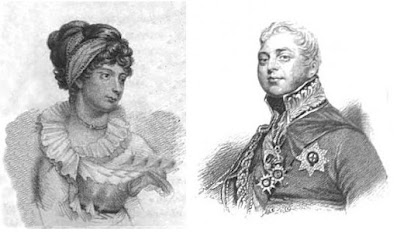 |
| The Duke and Duchess of Gloucester from A Biographical Memoir of Frederick, Duke of York and Albany by John Watkins (1827) |
George III loved his daughters but seemed reluctant to allow them to grow up. He was vehemently opposed to them marrying beneath them or marrying Catholics, which severely limited their choice of potential husbands, and was anxious that the elder should marry before the younger. As a result, none of his daughters were married before they were thirty and Princess Mary was no exception, not marrying until 1816, when, at the age of forty, she married her cousin, the Duke of Gloucester.
An enduring affection
It has been suggested that the attachment between the Duke of Gloucester and Princess Mary was of long-standing, but was thwarted by opposition and duty.
An enduring affection
It has been suggested that the attachment between the Duke of Gloucester and Princess Mary was of long-standing, but was thwarted by opposition and duty.
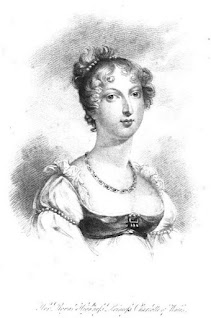 |
| Princess Charlotte from La Belle Assemblée (1816) |
When Princess Charlotte was born in 1796, thoughts immediately turned to potential marriage partners for the baby who was expected to be the future Queen of England. Being of royal blood and Protestant faith, the Duke of Gloucester was deemed to be a possible candidate and was consequently honour bound to remain single.
Although he was twenty years her senior, this does not seem to be too outrageous a suggestion because of the paucity of eligible husbands. However, whether this decision was made as a result of the duty or ambition of either the Duke or his parents, or indeed, a royal request, it is difficult to fathom.
Marriage of the Princess Charlotte
When Princess Charlotte broke off her engagement to Prince William of Orange in 1814, she seemed for a while to favour the Duke of Gloucester. However, her father detested his cousin and was adamant in his opposition to the match.
Charlotte then met and fell in love with Prince Leopold of Saxe-Coburg, and on 2 May 1816, they were married.
Although he was twenty years her senior, this does not seem to be too outrageous a suggestion because of the paucity of eligible husbands. However, whether this decision was made as a result of the duty or ambition of either the Duke or his parents, or indeed, a royal request, it is difficult to fathom.
Marriage of the Princess Charlotte
When Princess Charlotte broke off her engagement to Prince William of Orange in 1814, she seemed for a while to favour the Duke of Gloucester. However, her father detested his cousin and was adamant in his opposition to the match.
Charlotte then met and fell in love with Prince Leopold of Saxe-Coburg, and on 2 May 1816, they were married.
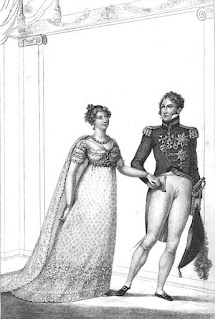 |
| Princess Charlotte and Prince Leopold from La Belle Assemblée (1816) |
Just two months later, on 22 July 18161, Mary married her cousin, William Frederick, the Duke of Gloucester. The Queen did not object to the match but the Prince Regent was not in favour for the same reasons that he had rejected his cousin as a suitor for his daughter. He had never liked the Duke and this dislike had grown when his cousin had openly supported his estranged wife, Princess Caroline. However, he had reluctantly given his consent when his much-loved sister asked for it. The alacrity with which the marriage was arranged after Princess Charlotte’s wedding seems to fit with the suggestion that the Duke was bound to her as long as she remained unmarried.
The wedding was a private affair and the guests were the same as those who had attended the Princess Charlotte’s wedding a few months before.
La Belle Assemblée gave this account of the wedding:
The wedding was a private affair and the guests were the same as those who had attended the Princess Charlotte’s wedding a few months before.
La Belle Assemblée gave this account of the wedding:
The altar
A superb altar was erected in the grand saloon of the Queen’s Palace: the new throne which was put up there directly over the principal door to the grand entrance, for the Queen to receive the addresses of the Princess Charlotte and the Prince Leopold, formed the back of the altar, which gave it an additional splendid appearance. The whole was formed of crimson velvet and gold lace, principally from the Chapel Royal and Whitehall chapel.2
The wedding dressThe foreign ambassadors with their ladies first entered the saloon followed by the cabinet ministers and their ladies, who proceeded to the right. The great officers of state and those of the royal households, except those in immediate attendance, took their stations to the left. The Queen placed herself on the left of the altar, in a state chair prepared for her: Princess Augusta, Elizabeth, the Duchess of York, and the Princess Sophia of Gloucester, went to her left, with their female attendants after them.The Prince Regent took his station on the right of the altar, with his royal brethren near him, Every thing being properly arranged, the Lord Chamberlain retired to introduce the Duke of Gloucester and present him to the altar.The Lord Chamberlain then, with the Duke of Cambridge, introduced the Princess Mary and the royal Duke, and presented her Royal Highness to the Prince Regent, who gave her away in marriage to the Duke of Gloucester.2
The following is a description of Princess Mary’s wedding dress:
Her Royal Highness looked most lovely. Her head-dress was without feathers, and she wore a brilliant fringed necklace: a bandeau of brilliants forming a wreath of roses encircled her forehead; a row of brilliant crescents, with light sprigs, as if issuing from their centres, formed a coronet, and was placed on the crown of her head. Her earrings were of pearl, and her girdle of brilliants, to correspond to the bandeau. Her bracelets of brilliants formed a chain, with flowers in the clasps, and a brilliant flower brooch adorned her bosom.2
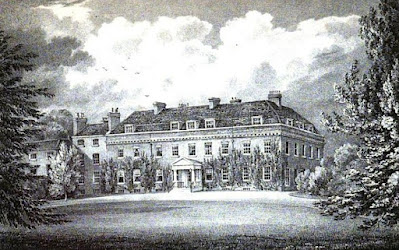 |
| Bagshot Park from Select Illustrations of the County of Surrey by GF Prosser (1828) |
At a quarter before ten o’clock the bride took off her nuptial ornaments, and arrayed in a white satin pelisse, with a white satin French bonnet, she set off with her royal husband to Bagshot, amidst the blessings and good wishes of her family, and the loud huzzas of the multitude assembled on the happy occasion.2
The Duke and Duchess of Gloucester entertained the inhabitants of Bagshot, where they were to live, on 6 August 1816 in celebration of their marriage. Over 1,000 people attended the entertainment with roast beef, plum pudding and fine ale served on the lawn at Bagshot
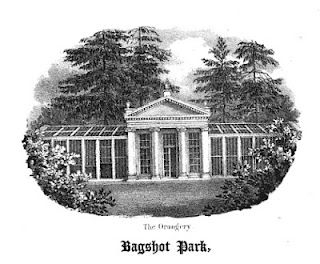 |
| The Orangery, Bagshot Park from Select Illustrations of the County of Surrey by GF Prosser (1828) |
It has been suggested that the marriage was not entirely happy and that the Duke was somewhat tyrannical in the management of his household. His politics certainly strained his relationship with the Prince Regent even further which cannot have helped family harmony.
However, I like to believe that the Duke and Duchess of Gloucester were happy. Mary must certainly have known her husband far better than was customary for ladies of her station. Queen Charlotte had met George III just hours before their marriage and the Prince of Wales had also agreed to marry a woman he had never seen, with disastrous consequences. The Duke has been described as boring and pompous but Mary was fond of him. Sadly, they had no children.
However, I like to believe that the Duke and Duchess of Gloucester were happy. Mary must certainly have known her husband far better than was customary for ladies of her station. Queen Charlotte had met George III just hours before their marriage and the Prince of Wales had also agreed to marry a woman he had never seen, with disastrous consequences. The Duke has been described as boring and pompous but Mary was fond of him. Sadly, they had no children.
Widowhood
The Duke died on 30 November 1834 and was buried in St George’s Chapel at Windsor. Mary survived him by over twenty years, living a retired life, but loved by many, including Queen Victoria and her family. She died on 20 April 1857 and was buried next to her husband.
 | ||
| Windsor Castle - the final resting place of the Duke and Duchess of Gloucester from Memoirs of Queen Charlotte by WC Oulton (1819) |
Rachel Knowles writes clean/Christian Regency era romance and historical non-fiction. She has been sharing her research on this blog since 2011. Rachel lives in the beautiful Georgian seaside town of Weymouth, Dorset, on the south coast of England, with her husband, Andrew.
Find out more about Rachel's books and sign up for her newsletter here.If you have enjoyed this blog and want to encourage me and help me to keep making my research freely available, please buy me a virtual cup of coffee by clicking the button below.
Note
1. Some sources state the date of the wedding as 23 July 1816.
1. Some sources state the date of the wedding as 23 July 1816.
2. All quotes from La Belle Assemblée (1816).
Sources used include:
Bell, John, La Belle Assemblée, various (1806-1831, London)
Hall, Mrs Matthew, The Royal Princesses of England (1871, London)
Hibbert, Christopher, George IV (Longmans,1972, Allen Lane, 1973, London)
Oulton, Walley Chamberlain, Authentic and Impartial Memoirs of Her Late Majesty Charlotte, Queen of Great Britain and Ireland (1819, London)
Prosser, GF, Select Illustrations of the County of Surrey comprising picturesque views of the seats of the nobility and gentry (C&J Rivington, 1828, London)
Purdue, AW, George III, daughters of (act.1766-1857), Oxford Dictionary of National Biography, (Oxford University Press, 2004, online edn, May 2009, accessed 10 Feb 2012)
Watkins, John, A Biographical Memoir of Frederick, Duke of York and Albany (1827, London)
Sources used include:
Bell, John, La Belle Assemblée, various (1806-1831, London)
Hall, Mrs Matthew, The Royal Princesses of England (1871, London)
Hibbert, Christopher, George IV (Longmans,1972, Allen Lane, 1973, London)
Oulton, Walley Chamberlain, Authentic and Impartial Memoirs of Her Late Majesty Charlotte, Queen of Great Britain and Ireland (1819, London)
Prosser, GF, Select Illustrations of the County of Surrey comprising picturesque views of the seats of the nobility and gentry (C&J Rivington, 1828, London)
Purdue, AW, George III, daughters of (act.1766-1857), Oxford Dictionary of National Biography, (Oxford University Press, 2004, online edn, May 2009, accessed 10 Feb 2012)
Watkins, John, A Biographical Memoir of Frederick, Duke of York and Albany (1827, London)


No comments:
New comments are not allowed.